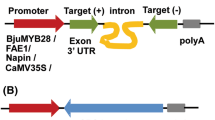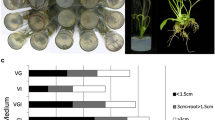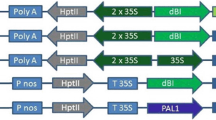Abstract
The berberine bridge enzyme cDNA bbe from Papaver somniferumL. was transformed in antisense orientation into seedling explants of the industrial elite line C048-6-14-64. In this way, 84 phenotypically normal T0 plants derived from embryogenic callus cultures were produced. The selfed progeny of these 84 plants yielded several T1 plants with an altered alkaloid profile. One of these plants T1-47, and its siblings T2-1.2 and T2-1.5 are the subject of the present work. The transformation of these plants was evaluated by PCR, and northern and Southern hybridisation. The transgenic plants contained one additional copy of the transgene. The alkaloid content in latex and roots was determined with HPLC and LC-MS. We observed an increased concentration of several pathway intermediates from all biosynthetic branches, e.g., reticuline, laudanine, laudanosine, dehydroreticuline, salutaridine and (S)-scoulerine. The transformation altered the ratio of morphinan and tetrahydrobenzylisoquinoline alkaloids in latex but not the benzophenanthridine alkaloids in roots. The altered alkaloid profile is heritable at least to the T2 generation. These results are the first example of metabolic engineering of the alkaloid pathways in opium poppy and, to our knowledge, the first time that an alkaloid biosynthetic gene has been transformed into the native species, followed by regeneration into a mature plant to enable analyses of the effect of the transgene on metabolism over several generations.
Similar content being viewed by others

References
V Bonhomme D Laurain-Mattar MA Fliniaux (2000) ArticleTitleEffects of the rol C gene on hairy root: Induction development and tropane alkaloid production by Atropa belladonna J Nat Prod 63 1249–1252
JA Chitty RS Allen AJ Fist PJ Larkin (2003) ArticleTitleGenetic transformation in commercial Tasmanian cultivars of opium poppy, Papaver somniferum, and movement of transgenic pollen in the field Functi Plant Biol 30 IssueID10 1045–1058
H Dittrich TM Kutchan (1991) ArticleTitleMolecular cloning, expression and induction of berberine bridge enzyme essential to the formation of benzophenanthridine alkaloids in the response of plants to pathogenic attack Proc Natl Acad Sci USA 88 9969–9973
PJ Facchini Luca V De (1995) ArticleTitlePhloem-specific expression of tyrosine/dopa decarboxylase genes and the biosynthesis of isoquinoline alkaloids in opium poppy Plant Cell 7 1811–1821
PJ Facchini SU Park (2003) ArticleTitleDevelopmental and inducible accumulation of gene transcripts involved in alkaloid biosynthesis in opium poppy Phytochemistry 64 177–186
PJ Facchini C Penzes AG Johnson D Bull (1996) ArticleTitleMolecular cloning and characterization of berberine bridge enzyme genes from opium poppy Plant Physiol 112 1669–1677
Frick S, Kramell R, Larkin PJ and Kutchan TM. Studying morphine biosynthesis using transgenic opium poppy (Papaver somniferum L.). Acta Hortic, in press.
FC Huang TM Kutchan (2000) ArticleTitleDistribution of morphinan and benzo[c]phenanthridine alkaloid gene transcript accumulation in Papaver somniferum Phytochemistry 53 555–564
TM Kutchan (1998) Molecular genetics of plant alkaloid biosynthesis. In: (ed) G Cordell (Eds) The Alkaloids Academic Press San Diego 253–316
Kutchan TM, Frick S and Weid M. Engineering plant alkaloid biosynthetic pathways–Progress and prospects. In: Nes WD and Lewis NG (eds.) Advances in Plant Biochemistry and Molecular Biology, Vol 1. Bioengineering and Molecular Biology of Plant Pathways, (Bohnert HJ and Nguyen HT eds), Elsevier Science Ltd, Oxford, in press.
GR Lazo PA Stein RA Ludwig (1991) ArticleTitleA DNA transformation-competent Arabidopsis genomic library in Agrobacterium Bio/Technology 9 963–967
T Maniatis EF Fritsch J Sambrook (1982) Molecular Cloning: a Laboratory Manual. Cold Spring Harbor Laboratory Press Cold Spring Harbor New York
E Moyano K Jouhikainen P Tammela J Palazón RM Cusidó MT Piñol TH Teeri K-M Oksman-Caldentey (2003) ArticleTitleEffect of pmt gene overexpression on tropane alkaloid production in transformed root cultures of Datura metel and Hyoscyamus muticus J Exp Bot 54 203–211
Niessen WMA (1999) Liquid Chromatography-Mass Spectrometry, Chapter 2. In: Introduction to Mass Spectrometry, 2nd edn. pp. 67-69, Marcel Decker.
SU Park M Yu P Facchini (2002) ArticleTitleAntisense RNA-mediated suppression of benzophenanthridine alkaloid biosynthesis in transgenic cell cultures of California poppy Plant Phys. 128 696–706
SU Park M Yu P Facchini (2003) ArticleTitleModulation of berberine bridge enzyme levels in transgenic root cultures of California poppy alters the accumulation of benzophenanthridine alkaloids Plant Mol Biol 51 153–164
K Raith R Neubert C Poeaknapo C Boettcher MH Zenk J Schmidt (2003) ArticleTitleElectrospray tandem mass spectrometric investigations of morphinans J Am Soc Mass Spectrom 14 1262–1269
PHD Schünmann DJ Llewwllyn B Surin P Boevink Feyter RC De PM Waterhouse (2003) ArticleTitleA suite of novel promoters and terminators for plant biotechnology Funct Plant Biol 29 443–452
Author information
Authors and Affiliations
Corresponding author
Rights and permissions
About this article
Cite this article
Frick, S., Chitty, J.A., Kramell, R. et al. Transformation of opium poppy (Papaver somniferumL.) with antisense berberine bridge enzyme gene (anti-bbe) via somatic embryogenesis results in an altered ratio of alkaloids in latex but not in roots. Transgenic Res 13, 607–613 (2004). https://doi.org/10.1007/s11248-004-2892-6
Received:
Revised:
Accepted:
Issue Date:
DOI: https://doi.org/10.1007/s11248-004-2892-6



